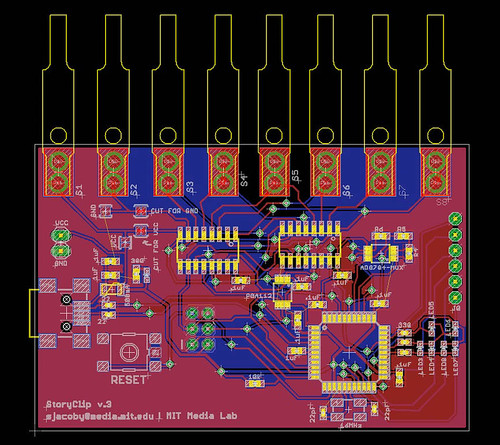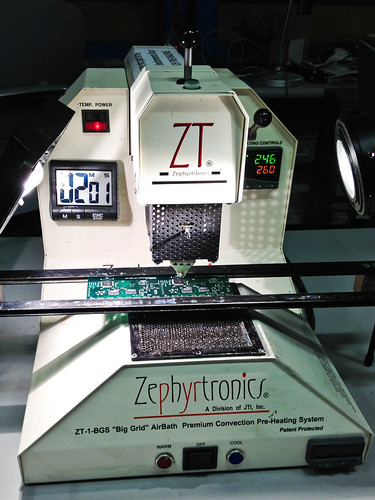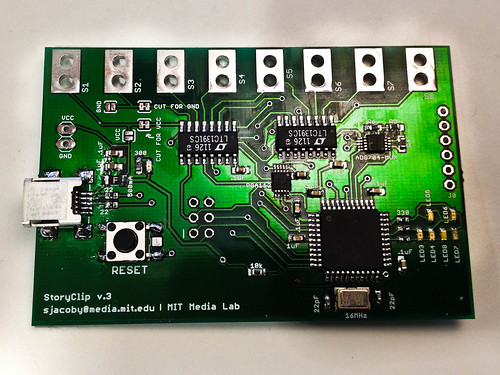2015-03-02 21:47:19 : Updating layout for new blocks.
»
Find 3a8c3faf3cf2ac8144b1050f4c387551018b567b on GitHub.
Updating layout for new blocks.
- SenseClip
thumbnail: hidden-layers-1.jpg
---
{+{% block post %}+}
{% mark excerpt %}
_The journey continues. This is part of my work as a research assistant in the [High-Low Tech](http://hlt.media.mit.edu) group at the MIT Media Lab._
@@ -35,9 +36,5 @@ It turns out, though, the job wasn't really done. The pouring algorithm had done
At any rate, lesson learned. Don't switch off views and think you've solved any problems. You haven't.
{{ macros.render_footnote("airwires", "1", "Airwires are just a wire that you're supposed to solder on later, so it's displayed as a single line in Eagle. That's all well and good and sometimes a well-placed airwire can take care of a number of problems--but they're difficult and tedious to solder, and really, if you're having a custom-board made, you should take care not to have any.")}}
{+{% endblock %}+}
2015-02-16 14:28:44 : Adding excerpts to all posts, basically.
»
Find 07a57fe3ebb846616f1ae7d0aa3cfbc0f1920d57 on GitHub.
Adding excerpts to all posts, basically.
- SenseClip
thumbnail: hidden-layers-1.jpg
---
{+{% mark excerpt %}+}
_The journey continues. This is part of my work as a research assistant in the [High-Low Tech](http://hlt.media.mit.edu) group at the MIT Media Lab._
This is the design that I drew the board up from. Looks pretty good, right? Well, I was happy: lot's of complicated little parts, colors--enough for me to feel like I was doing my job.
{+{% endmark %}+}
{{ macros.render_figure('<a href="http://www.flickr.com/photos/samjacoby/8233965024/" title="Screen shot 2012-11-30 at 6.55.07 PM by s_jacoby, on Flickr"><img src="http://farm9.staticflickr.com/8062/8233965024_7826261394.jpg" width="500" height="445" alt="Screen shot 2012-11-30 at 6.55.07 PM"></a>', "An electro-rainbow.") }}
2014-06-22 17:18:19 : I must have been on drugs.
»
Find e2c5926e08b4740bf2b34e6e5fbff6960e8cd39e on GitHub.
I must have been on drugs.
The finished board, bristling with muxes and PGAs and all the rest. Looks pretty good.
{{ macros.render_figure('<a href="http://www.flickr.com/photos/samjacoby/8232901503/" title="IMG_2299 by s_jacoby, on Flickr"><img src="http://farm9.staticflickr.com/8350/8232901503_68b725bb1b.jpg" width="500" height="375" alt="IMG_2299"></a>', "StoryClip = TapClip = ?")}}
Now, some of the savvier among you may note that there are substantial errors in this circuit. To you, I tip my hat. [-But such a realiziation is still ahead of me. The train rushes forward, splitting the night. The misthrown switch is still miles ahead in the darkness, its discovery yet to come.-]{+I was oblivious.+}
At the moment, our hero is plugging the board into his computer, ready to bask in the[-mild-] radiance of its green, power LED.
Nothing. Poke around a bit. Nothing. Pull out the multimeter. Could there be a bridge in thin traces of the mini-USB connectior? No. 5V streaming in. That looks good. But, hmm, streaming out? Ah...well, not so much. And then I see it. None of the grounds are connected. Only one half of my circuits are routed.
@@ -30,12 +30,8 @@ Here's the story. It's not so grand. At some point in the development process, I
It turns out, though, the job wasn't really done. The pouring algorithm had done its job, sure--but it had left a number of sections for me, it's human-companion to resolve. The groundplane needed a number of additional airwires that I never added back in. My circuits, then, were a series of orphans, plugged into nothing but themselves! I needed _17_ additional wires. I was crushed.
[-This is what happened to me, albeit, on a kind of tiny, bemused scale: shock, grief, denial, self-doubt, irritation, annoyance &c. The stages of the technical oversight. -]
At any rate, lesson learned. Don't switch off views and think you've solved any problems. You haven't.
[-And so ends this mild saga of workplace-challenges. -]
{{ macros.render_footnote("airwires", "1", "Airwires are just a wire that you're supposed to solder on later, so it's displayed as a single line in Eagle. That's all well and good and sometimes a well-placed airwire can take care of a number of problems--but they're difficult and tedious to solder, and really, if you're having a custom-board made, you should take care not to have any.")}}
2013-01-29 18:40:51 : Start displaying .git tracking information
»
Find cfa46ecb8a0244c3a1d4650cff13dc9294381b44 on GitHub.
Start displaying .git tracking information
title: Hidden Layers
summary: In which I am screwed by layers in Eagle.
date: 2012-11-15 18:37:09
{+track: True+}
tags:
- SenseClip
thumbnail: hidden-layers-1.jpg
2012-12-11 23:24:25 : Keeping track of the generalities of the mentals.
»
Find db1fd991b3ea34429d47856c77e32ede5c8a3569 on GitHub.
Keeping track of the generalities of the mentals.
date: 2012-11-15 18:37:09
tags:
- SenseClip
{+thumbnail: hidden-layers-1.jpg+}
---
_The journey continues. This is part of my work as a research assistant in the [High-Low Tech](http://hlt.media.mit.edu) group at the MIT Media Lab._
2012-12-10 15:41:13 : Exclude these for now.
»
Find 4204a93bcc35d5b8ab63132184e029f408949434 on GitHub.
Exclude these for now.
Nothing. Poke around a bit. Nothing. Pull out the multimeter. Could there be a bridge in thin traces of the mini-USB connectior? No. 5V streaming in. That looks good. But, hmm, streaming out? Ah...well, not so much. And then I see it. None of the grounds are connected. Only one half of my circuits are routed.
Here's the story. It's not so grand. At some point in the development process, I did something bad. To simplify my design, I used a ground plane--a single sheet of copper that the ground of all of the traces plugged into. After "pouring" the ground (kind've like the fill tool in paint, or something), the screen was looking a little crowded. I turned off its display. Great. In so doing, though, I also turned off the airwires{{ [-macros.renderfootnote("footnote-fail-1",-]{+macros.render_footnote("airwires",+} "1")}} that it came with. Naturally, I then promptly forgot I did any such thing and proceeded on my merry way. Getting the board made and all the rest.
It turns out, though, the job wasn't really done. The pouring algorithm had done its job, sure--but it had left a number of sections for me, it's human-companion to resolve. The groundplane needed a number of additional airwires that I never added back in. My circuits, then, were a series of orphans, plugged into nothing but themselves! I needed _17_ additional wires. I was crushed.
@@ -34,4 +34,10 @@ At any rate, lesson learned. Don't switch off views and think you've solved any
And so ends this mild saga of workplace-challenges.
{+{{ macros.render_footnote("airwires", "1", "Airwires are just a wire that you're supposed to solder on later, so it's displayed as a single line in Eagle. That's all well and good and sometimes a well-placed airwire can take care of a number of problems--but they're difficult and tedious to solder, and really, if you're having a custom-board made, you should take care not to have any.")}}+}
2012-12-07 23:27:35 : Tweaks, home.
»
Find 2ed01935bceee5b6442dcecff2aa7fcc7d0dc68b on GitHub.
Tweaks, home.
The finished board, bristling with muxes and PGAs and all the rest. Looks pretty good.
{{ macros.render_figure('<a href="http://www.flickr.com/photos/samjacoby/8232901503/" title="IMG_2299 by s_jacoby, on Flickr"><img src="http://farm9.staticflickr.com/8350/8232901503_68b725bb1b.jpg" width="500" height="375" alt="IMG_2299"></a>', [-"")}}-]{+"StoryClip = TapClip = ?")}}+}
Now, some of the savvier among you may note that there are substantial errors in this circuit. To you, I tip my hat. But such a realiziation is still ahead of me. The train rushes forward, splitting the night. The misthrown switch is still miles ahead in the darkness, its discovery yet to come.
At the moment, our hero is plugging the board into his computer, ready to bask in the mild radiance of its green, power LED.
2012-12-07 14:45:18 : Tweaked.
»
Find a96c7ec2058f07bdbb5a5449d91c4bd05e5ebe1d on GitHub.
Tweaked.
{{ macros.render_figure('<a href="http://www.flickr.com/photos/samjacoby/8233965024/" title="Screen shot 2012-11-30 at 6.55.07 PM by s_jacoby, on Flickr"><img src="http://farm9.staticflickr.com/8062/8233965024_7826261394.jpg" width="500" height="445" alt="Screen shot 2012-11-30 at 6.55.07 PM"></a>', "An electro-rainbow.") }}
[-So naturally,-]I sent off the gerber files, and had another board made by the good men and women of AP Circuits. They did bang-up job, naturally. I was walking around the lab with them, and Mark said, "That from AP Circuits?" You can spot one of these gems from across the room--it's in the fancy-pants solder mask, apparently. Whatever the reason, you can spot one of these gems from across the room: circuit bling. I happily toasted it up.
{{ macros.render_figure('<a href="http://www.flickr.com/photos/samjacoby/8233964610/" title="IMG_2281 by s_jacoby, on Flickr"><img src="http://farm9.staticflickr.com/8340/8233964610_036da21ae3.jpg" width="375" height="500" alt="IMG_2281"></a>', "That's 246 ℃ ")}}
2012-12-02 16:00:59 : Yo.
»
Find 1aa554b4ee6451d701a7cf6df69e08609a63bc90 on GitHub.
Yo.
---
title: Hidden Layers
summary: In which I [-learn to treat my tools with wary respect.-]{+am screwed by layers in Eagle.+}
date: 2012-11-15 18:37:09
tags:
- SenseClip
@@ -18,9 +18,11 @@ So naturally, I sent off the gerber files, and had another board made by the goo
The finished board, bristling with muxes and PGAs and all the rest. Looks pretty good.
{{ macros.render_figure('<a href="http://www.flickr.com/photos/samjacoby/8232901503/" title="IMG_2299 by s_jacoby, on Flickr"><img src="http://farm9.staticflickr.com/8350/8232901503_68b725bb1b.jpg" width="500" height="375" alt="IMG_2299"></a>', "")}}
Now, some of the savvier among you may note that there are substantial errors in this circuit. To you, I [-say, I care not--for I forge ahead like-]{+tip my hat. But such+} a {+realiziation is still ahead of me. The+} train [-in-]{+rushes forward, splitting+} the night. [-At any rate, that discovery is yet to come. At the moment, our hero-]{+The misthrown switch+} is [-plugging the board into his computer, ready to bask-]{+still miles ahead+} in the [-mild radiance of-]{+darkness,+} its [-green, power LED.-]{+discovery yet to come.+}
{+At the moment, our hero is plugging the board into his computer, ready to bask in the mild radiance of its green, power LED.+}
Nothing. Poke around a bit. Nothing. Pull out the multimeter. {+Could there be a bridge in thin traces of the mini-USB connectior? No.+} 5V streaming in. [-But-]{+That looks good. But, hmm,+} streaming out? Ah...well, not so much. And then I see it. {+None of the grounds are connected. Only one half of my circuits are routed.+}
Here's the story. It's not so grand. At some point in the development process, I did something bad. To simplify my design, I used a ground plane--a single sheet of copper that the ground of all of the traces plugged into. After "pouring" the ground (kind've like the fill tool in paint, or something), the screen was looking a little crowded. I turned off its display. Great. In so doing, though, I also turned off the airwires{{ macros.renderfootnote("footnote-fail-1", "1")}} that it came with. Naturally, I then promptly forgot I did any such thing and proceeded on my merry way. Getting the board made and all the rest.
@@ -28,9 +30,8 @@ It turns out, though, the job wasn't really done. The pouring algorithm had done
This is what happened to me, albeit, on a kind of tiny, bemused scale: shock, grief, denial, self-doubt, irritation, annoyance &c. The stages of the technical oversight.
{+At any rate, lesson learned. Don't switch off views and think you've solved any problems. You haven't.+}
[-At any rate, lesson learned. Don't switch off views and think you've solved the problems they showed. You haven't.-]And so ends this mild saga [-in-]{+of+} workplace-challenges.
2012-11-30 22:35:16 : Push it, boy.
»
Find 7f5b3eaad64482b59cf45d74a76d598efd156bda on GitHub.
Push it, boy.
@@ -0,0 +1,36 @@
{+---+}
{+title: Hidden Layers+}
{+summary: In which I learn to treat my tools with wary respect. +}
{+date: 2012-11-15 18:37:09+}
{+tags:+}
{+ - SenseClip+}
{+---+}
{+_The journey continues. This is part of my work as a research assistant in the [High-Low Tech](http://hlt.media.mit.edu) group at the MIT Media Lab._+}
{+This is the design that I drew the board up from. Looks pretty good, right? Well, I was happy: lot's of complicated little parts, colors--enough for me to feel like I was doing my job. +}
{+{{ macros.render_figure('<a href="http://www.flickr.com/photos/samjacoby/8233965024/" title="Screen shot 2012-11-30 at 6.55.07 PM by s_jacoby, on Flickr"><img src="http://farm9.staticflickr.com/8062/8233965024_7826261394.jpg" width="500" height="445" alt="Screen shot 2012-11-30 at 6.55.07 PM"></a>', "An electro-rainbow.") }}+}
{+So naturally, I sent off the gerber files, and had another board made by the good men and women of AP Circuits. They did bang-up job, naturally. I was walking around the lab with them, and Mark said, "That from AP Circuits?" You can spot one of these gems from across the room--it's in the fancy-pants solder mask, apparently. Whatever the reason, you can spot one of these gems from across the room: circuit bling. I happily toasted it up. +}
{+{{ macros.render_figure('<a href="http://www.flickr.com/photos/samjacoby/8233964610/" title="IMG_2281 by s_jacoby, on Flickr"><img src="http://farm9.staticflickr.com/8340/8233964610_036da21ae3.jpg" width="375" height="500" alt="IMG_2281"></a>', "That's 246 ℃ ")}}+}
{+The finished board, bristling with muxes and PGAs and all the rest. Looks pretty good. +}
{+{{ macros.render_figure('<a href="http://www.flickr.com/photos/samjacoby/8232901503/" title="IMG_2299 by s_jacoby, on Flickr"><img src="http://farm9.staticflickr.com/8350/8232901503_68b725bb1b.jpg" width="500" height="375" alt="IMG_2299"></a>', "")}}+}
{+Now, some of the savvier among you may note that there are substantial errors in this circuit. To you, I say, I care not--for I forge ahead like a train in the night. At any rate, that discovery is yet to come. At the moment, our hero is plugging the board into his computer, ready to bask in the mild radiance of its green, power LED.+}
{+Nothing. Poke around a bit. Nothing. Pull out the multimeter. 5V streaming in. But streaming out? Ah...well, not so much. And then I see it. +}
{+Here's the story. It's not so grand. At some point in the development process, I did something bad. To simplify my design, I used a ground plane--a single sheet of copper that the ground of all of the traces plugged into. After "pouring" the ground (kind've like the fill tool in paint, or something), the screen was looking a little crowded. I turned off its display. Great. In so doing, though, I also turned off the airwires{{ macros.renderfootnote("footnote-fail-1", "1")}} that it came with. Naturally, I then promptly forgot I did any such thing and proceeded on my merry way. Getting the board made and all the rest. +}
{+It turns out, though, the job wasn't really done. The pouring algorithm had done its job, sure--but it had left a number of sections for me, it's human-companion to resolve. The groundplane needed a number of additional airwires that I never added back in. My circuits, then, were a series of orphans, plugged into nothing but themselves! I needed _17_ additional wires. I was crushed. +}
{+This is what happened to me, albeit, on a kind of tiny, bemused scale: shock, grief, denial, self-doubt, irritation, annoyance &c. The stages of the technical oversight. +}
{+At any rate, lesson learned. Don't switch off views and think you've solved the problems they showed. You haven't. +}
{+And so ends this mild saga in workplace-challenges.+}


